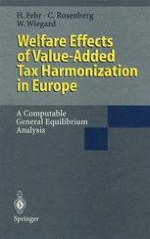1995 | OriginalPaper | Buchkapitel
From Theory to Application: A Computable General Equilibrium Model
verfasst von : Dr. Hans Fehr, Dr. Christoph Rosenberg, Professor Dr. Wolfgang Wiegard
Erschienen in: Welfare Effects of Value-Added Tax Harmonization in Europe
Verlag: Springer Berlin Heidelberg
Enthalten in: Professional Book Archive
Aktivieren Sie unsere intelligente Suche, um passende Fachinhalte oder Patente zu finden.
Wählen Sie Textabschnitte aus um mit Künstlicher Intelligenz passenden Patente zu finden. powered by
Markieren Sie Textabschnitte, um KI-gestützt weitere passende Inhalte zu finden. powered by
We are now equipped with some theoretical insights into the welfare effects of value-added taxes in open economies. We know that international income effects as well as domestic and international substitution effects matter and we have elaborated on the determinants of these effects. Theoretical reasoning alone, however, does not tell us much about the quantitative significance of these effects, which are exactly what we are interested in. Which countries realize welfare gains, and which suffer welfare losses, when the EU switches from one international taxation principle to another? Furthermore we want to know whether or not welfare changes are quantitatively significant, and what counts more for welfare changes, international income effects or efficiency considerations due to substitution effects? In Chapter I we argued that computable general equilibrium (CGE) models were the best way of answering these and related questions. Hence, the aim of the present chapter is to develop and describe our computable general equilibrium model in more detail.
